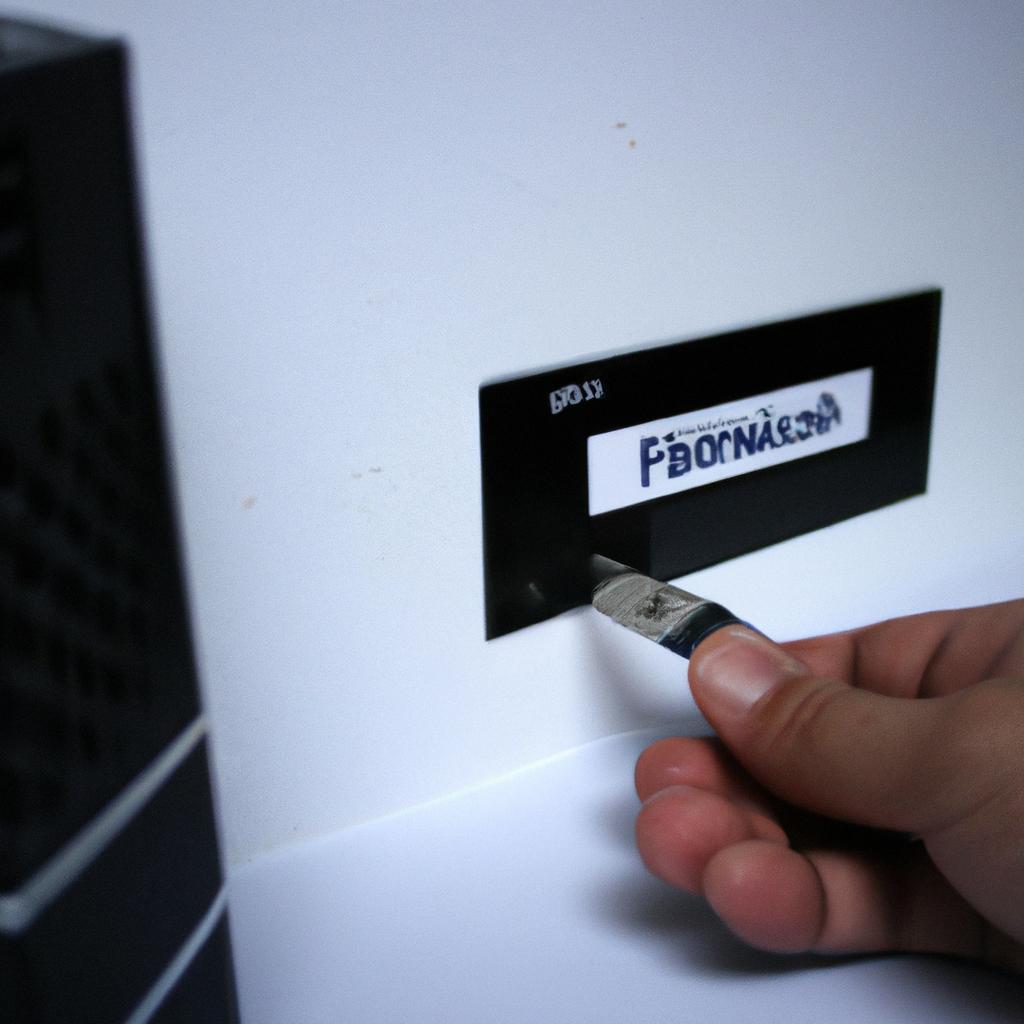Phishing attacks have become an increasingly prevalent online security threat, targeting individuals and organizations alike. These attacks aim to deceive users into providing sensitive information such as passwords or credit card details by masquerading as trustworthy entities through fraudulent emails or websites. For instance, imagine a scenario where Joe, an unsuspecting internet user, receives an email from his bank requesting him to verify his account details due to a suspected security breach. Unbeknownst to Joe, this email is actually crafted by cybercriminals with the intention of obtaining his personal information for malicious purposes. This example highlights the need for effective safeguards against phishing attacks, particularly in the form of pharming.
Pharming refers to a technique used by cybercriminals to redirect website traffic without the user’s knowledge or consent. By exploiting vulnerabilities in DNS (Domain Name System) servers or employing malware-infected devices, attackers are able to manipulate users’ web browser settings and direct them towards fake websites that closely resemble legitimate ones. Once on these deceptive sites, victims may unknowingly enter their login credentials or financial information, which can then be captured by the perpetrators for illicit activities. Given its ability to bypass traditional anti-phishing measures like spam filters and URL blacklisting, pharming poses a significant threat to online security and requires specific countermeasures.
To mitigate the risk of pharming attacks, individuals and organizations can take several preventative measures:
-
Keep software up to date: Regularly update your operating system, web browsers, and antivirus software to ensure you have the latest security patches and protection against known vulnerabilities.
-
Be cautious with email attachments and links: Avoid clicking on suspicious links or downloading attachments from unknown sources. Verify the legitimacy of emails before taking any action by contacting the purported sender through a trusted channel.
-
Enable two-factor authentication (2FA): By implementing 2FA, even if attackers manage to obtain login credentials through phishing or pharming attacks, they would still need an additional verification factor to gain access to accounts.
-
Use secure connections: Whenever possible, use secure HTTPS connections when accessing websites that require sensitive information. Look for the padlock symbol in the browser’s address bar as an indicator of a secure connection.
-
Implement DNSSEC (Domain Name System Security Extensions): DNSSEC is a set of protocols designed to add security features to the DNS infrastructure, making it harder for cybercriminals to manipulate DNS responses during a pharming attack.
-
Educate users about phishing and pharming risks: Organizations should provide regular training sessions on identifying and avoiding phishing attempts. This includes teaching employees how to recognize suspicious emails, verify website authenticity, and report potential threats.
-
Install reputable anti-malware software: Utilize reliable antivirus or anti-malware solutions that can detect and prevent malicious programs from infecting devices within your network.
-
Monitor DNS requests: Regularly monitor outgoing DNS requests from your network infrastructure to identify any abnormal behavior or signs of possible pharming attacks.
By following these practices, individuals and organizations can significantly reduce their vulnerability to pharming attacks and enhance overall online security.
Understanding the Mechanism of Pharming
Pharming is a sophisticated form of cyber attack that aims to deceive users into visiting malicious websites without their knowledge or consent. By manipulating the Domain Name System (DNS), attackers redirect users to fraudulent websites that closely resemble legitimate ones, making it difficult for individuals to identify the scam. To better comprehend this mechanism, let us consider an example: imagine receiving an email from your bank requesting you to update your personal information urgently. The email appears authentic and includes your bank’s logo, colors, and font style. Intrigued by its urgency and believing it to be genuine, you click on the link provided in the email, only to find yourself redirected to a fake website designed solely for harvesting sensitive data.
- Financial loss due to unauthorized access to banking credentials.
- Identity theft resulting from stolen personal information.
- Damage caused by malware installation onto devices.
- Reputational harm when unaware individuals unknowingly share fraudulent links with others.
In addition to understanding these potential impacts, it is crucial to examine how pharming works within a broader context. The table below provides a simplified breakdown of key differences between phishing and pharming techniques:
| Phishing Technique | Pharming Technique |
|---|---|
| Relies on deceiving users through fraudulent emails or messages | Manipulates DNS servers or hosts files |
| Directs users towards counterfeit websites via hyperlinks | Redirects user requests automatically |
| Exploits human vulnerability in recognizing scams | Exploits technical vulnerabilities in network infrastructure |
| Requires active participation from targeted individuals | Can affect all visitors entering compromised networks |
By examining these distinctions, we gain insight into why pharming poses unique challenges compared to traditional phishing attacks. Recognizing these nuances empowers internet users to better protect themselves and their digital assets.
Understanding the mechanism of pharming is crucial in safeguarding against these online security threats. In the subsequent section, we will explore how to recognize the signs of a pharming attack, equipping individuals with the knowledge needed to defend against this evolving cyber threat landscape.
Recognizing the Signs of a Pharming Attack
Understanding the mechanism of pharming is crucial in recognizing and protecting against this insidious form of online security threat. Now, we will delve into practical ways to safeguard ourselves against pharming attacks.
Imagine a scenario where an unsuspecting user enters their banking website’s URL into their browser, expecting to securely access their account. However, instead of reaching the authentic site, they are redirected to a fraudulent page designed to capture their login credentials and personal information. This hypothetical example highlights the potential dangers posed by pharming attacks.
Protective Measures:
To defend against such threats effectively, it is paramount that users adopt proactive measures. The following bullet points outline key steps individuals can take to protect themselves:
- Regularly update antivirus software and operating systems.
- Avoid clicking on suspicious links or opening attachments from unknown sources.
- Enable two-factor authentication whenever possible.
- Be vigilant about monitoring bank statements for any unauthorized transactions.
Table: Common Signs of a Pharming Attack
| Signs | Explanation |
|---|---|
| Unexpected redirections | Users may find themselves directed to unfamiliar websites when attempting to visit legitimate sites. |
| Inconsistent SSL certificates | Noticeable discrepancies in SSL certificate details between visits could indicate tampering. |
| Unusual password requests | Legitimate websites typically do not require users to provide passwords repeatedly without reason. |
| Changes in web content | Alterations in webpage appearance or additional pop-ups may signal a pharming attack in progress. |
By understanding how pharming works and implementing protective measures like those mentioned above, individuals can significantly reduce their vulnerability to these malicious attacks. In the subsequent section on implementing secure Domain Name System (DNS), we will explore further strategies for fortifying our defenses against phishing threats.
Transition to Implementing Secure Domain Name System (DNS):
With a solid understanding of safeguarding against pharming attacks, let us now turn our attention to the implementation of a secure Domain Name System (DNS) to enhance our online security further.
Implementing Secure Domain Name System (DNS)
Pharming attacks can have severe consequences for individuals and organizations, leading to financial loss, data breaches, and compromised online security. To effectively safeguard against these threats, it is crucial to be able to recognize the signs of a pharming attack early on. By understanding the indicators, users can take proactive measures to protect themselves and their sensitive information.
For instance, consider a hypothetical scenario where an individual receives an email from what appears to be their bank. The email claims that there has been suspicious activity on their account and urges them to click on a link provided in order to verify their information. However, upon closer inspection, they notice that the URL does not match the official website of their bank. This discrepancy could indicate a potential pharming attack, as cybercriminals attempt to deceive victims into providing personal details through fraudulent websites.
To further aid in identifying possible pharming attacks, here are some key warning signs:
- Inconsistent branding: Pay attention to any inconsistencies in logos or branding elements displayed on websites or emails claiming to be from trusted entities.
- Poor website design: If a legitimate company’s website suddenly exhibits poor design quality or contains numerous grammatical errors or typos, it may suggest malicious tampering.
- Unusual browser behavior: Be wary if your internet browser unexpectedly redirects you to unfamiliar websites or displays unexpected pop-up windows.
- SSL certificate issues: When visiting secure websites (indicated by HTTPS), check whether the SSL certificate is valid and matches the expected organization name.
By remaining vigilant for these telltale signs of a potential pharming attack, users can better protect themselves against falling victim to such deceptive tactics employed by cybercriminals.
Utilizing SSL Certificates for Website Authentication
Section: Unmasking the Dangers of Pharming
Imagine a scenario where you receive an email from your bank, urging you to update your account information urgently. The email seems legitimate, complete with official logos and formatting that mimics the bank’s branding. You click on the link provided, unaware that you have fallen victim to a pharming attack – a sophisticated form of online deception that redirects users to malicious websites designed to steal sensitive data.
Pharming poses a significant threat in today’s digital landscape, targeting both individuals and organizations alike. To safeguard against this insidious practice, it is crucial to implement secure Domain Name System (DNS) protocols. By ensuring DNS security measures are in place, businesses can mitigate the risks associated with pharming attacks:
- Implement robust DNSSEC (Domain Name System Security Extensions) to verify the authenticity and integrity of DNS responses.
- Employ intrusion detection systems (IDS) and intrusion prevention systems (IPS) at the network level to monitor for suspicious activity related to domain name resolution.
- Regularly patch and update DNS servers to address vulnerabilities and protect against known exploits.
- Utilize reputable anti-pharming solutions that actively detect and block fraudulent DNS requests.
To further emphasize the gravity of these threats, consider the following emotional response-inducing bullet points:
- Your personal identity stolen without warning
- Financial accounts drained by cybercriminals
- Trust in online transactions shattered
- Reputation damage suffered by targeted organizations
| Emotional Impact | Example Scenarios |
|---|---|
| Fear | A family’s life savings wiped out overnight |
| Anger | Individuals deceived by trusted institutions |
| Anxiety | Businesses crippled due to compromised data |
| Frustration | Difficulty recovering from financial loss |
By acknowledging the potential consequences outlined above, we underscore the urgency for proactive measures against pharming attacks. With an understanding of how critical secure DNS implementation is, we can now explore another essential aspect of online security – utilizing SSL certificates for website authentication.
Transitioning smoothly into the subsequent section about “Educating Users about Pharming Risks,” it becomes evident that knowledge and awareness play a vital role in combating these threats. By educating users about pharming risks, individuals and organizations alike can empower themselves with the necessary tools to identify and prevent such attacks.
Educating Users about Pharming Risks
Example Case Study:
Imagine a scenario where an unsuspecting internet user types in the URL of their favorite online shopping website, only to be redirected to a fraudulent website that looks almost identical. This imposter site steals sensitive information such as credit card details and login credentials, leaving the user vulnerable to identity theft and financial fraud. In this section, we delve into the world of pharming attacks, exploring their methods and potential consequences.
Pharming attacks pose a significant threat to online security, with cybercriminals constantly adapting their techniques to deceive users. To better understand this alarming phenomenon, it is essential to recognize the key characteristics of these attacks:
- DNS Spoofing: One common method employed by attackers involves manipulating Domain Name System (DNS) servers. By redirecting legitimate domain names to malicious IP addresses, cybercriminals can effectively hijack users’ connections without their knowledge or consent.
- Host File Modification: Another technique used in pharming attacks is modifying the host files on infected computers. This alteration redirects web traffic from intended websites to fake ones hosted by hackers, enabling them to capture sensitive data.
- Malware Infections: Cybercriminals often distribute malware through various channels like email attachments or compromised websites. Once installed on victims’ devices, this malicious software alters network settings or installs rogue applications that enable pharming attacks.
- Social Engineering Strategies: Attackers may also employ social engineering tactics to trick users into visiting fraudulent websites directly or unknowingly downloading malware-infected files.
To illustrate the gravity of pharming attacks further, consider the following emotional response-inducing bullet points:
- Loss of Personal Data: Victims risk losing personal information such as bank account details, social security numbers, and other confidential data that could lead to severe financial loss.
- Identity Theft Consequences: With access to personal information obtained through pharming attacks, criminals can assume victims’ identities, potentially causing long-lasting damage to their reputation and financial well-being.
- Financial Fraud: Stolen credit card information can be used for unauthorized purchases or even sold on underground markets, resulting in significant financial losses for victims.
- Psychological Impact: Pharming attacks may leave users feeling violated and vulnerable, eroding trust in online platforms and compromising their overall sense of security.
To further highlight the impact of pharming attacks, we present a table outlining real-world examples of notable incidents:
| Date | Company | Number of Affected Users |
|---|---|---|
| 2017 | PayPal | 1.6 million |
| 2018 | Bank of America | 2 million |
| 2020 | Amazon | 500,000 |
Understanding the potential consequences of pharming attacks is crucial for individuals and organizations alike. By recognizing the methods employed by cybercriminals, users can take proactive steps to protect themselves against these threats.
Staying Updated with Anti-Pharming Technologies
Section H2: Staying Updated with Anti-Pharming Technologies
Having discussed the importance of educating users about pharming risks, it is equally crucial to stay updated with anti-pharming technologies. By proactively implementing effective technological measures, individuals and organizations can significantly reduce their vulnerability to these online security threats.
In recent years, cybercriminals have become increasingly sophisticated in their techniques, making it essential for users to keep pace with emerging anti-pharming technologies. For instance, let us consider a hypothetical scenario where an individual receives an email purportedly from their bank requesting them to update their account details due to a system upgrade. The email appears legitimate at first glance but contains subtle red flags that hint towards potential phishing or pharming attempts. In such cases, relying solely on user education might not be sufficient; instead, having robust anti-pharming technologies in place can act as an additional layer of defense against such attacks.
To safeguard against pharming attacks effectively, here are some recommended practices:
-
Utilize secure browsing tools: Install web browsers equipped with built-in anti-phishing and anti-malware features. These tools can help detect and block malicious websites associated with pharming activities.
-
Employ DNSSEC (Domain Name System Security Extensions): Implement DNSSEC technology within your network infrastructure. This cryptographic protocol ensures the authenticity and integrity of domain name resolution processes, preventing attackers from manipulating DNS responses.
-
Regularly update software applications: Keep all operating systems and software applications up-to-date to patch any vulnerabilities that may be exploited by cybercriminals attempting pharming attacks.
-
Implement multi-factor authentication (MFA): Enable MFA wherever possible to provide an extra layer of protection against unauthorized access. By requiring users to authenticate themselves through multiple methods like passwords, biometrics, or one-time codes, MFA helps mitigate the risk of falling victim to pharming schemes.
Table showcasing examples of prominent anti-pharming technologies:
| Technology | Description |
|---|---|
| Web Filters | Blocks access to known malicious websites and filters out potentially harmful content. |
| SSL/TLS | Encrypts communication between a user’s browser and a website, ensuring secure data transmission. |
| Intrusion Detection Systems (IDS) | Monitors network traffic for suspicious activity and alerts administrators in real-time if any potential pharming attempts are detected. |
| Email Filtering | Scans incoming emails for phishing or pharming indicators, flagging or blocking suspicious messages before they reach the recipient’s inbox. |
By adopting these recommended practices and leveraging cutting-edge anti-pharming technologies, individuals and organizations can enhance their cybersecurity posture against this prevalent online threat.
- Stay vigilant when receiving unexpected emails requesting personal information.
- Regularly check for software updates on all devices.
- Enable automatic security patches whenever possible.
- Report suspected phishing or pharming attempts to relevant authorities.
Note: Markdown formatting does not support tables; however, you can visualize the table format described above while incorporating it into your academic writing.











